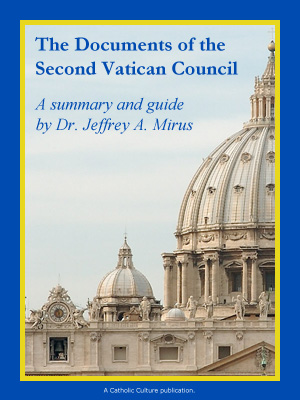The Self-Secularization Process
By Dr. Jeff Mirus ( bio - articles - email ) | Sep 10, 2009
I want to begin here with the closing statement of my last installment: “Self-secularization does not always involve direct falsehood, nor is it found only in formal presentations, such as speaking, writing, preaching or teaching.” (See Self-Secularization and the Whole Truth.)
When I say that self-secularization need not always involve direct falsehood, I am referring to specific statements contrary to fact. If these are not present in a given case, there will still be an indirect sort of falsehood, the false impression that one has fully communicated some spiritual reality when in fact critical aspects have been concealed to accommodate the world. This may be the result either of a deliberate decision to conform or of a habit of conformity through which one’s own beliefs have gradually altered.
It is also true that if a self-secularizing Catholic “intellectual” is challenged for communicating a direct falsehood, he will very likely respond that he is merely exploring an especially useful aspect of the truth. Consider again the theologian described earlier who explained the Eucharist in symbolic terms. If challenged (even by the Congregation for the Doctrine of the Faith), he might counter that he is not denying anything; rather, he merely wishes to emphasize what in our own day is an important dimension of Eucharistic reality. The problem here is that nobody who really cares about a proper understanding of the Eucharist will proceed in this way.
If for some reason our theologian wished to speak faithfully about the symbolism inherent in the Eucharist, then—precisely to avoid an attenuated doctrine—he would carefully emphasize that its symbolism is an additional point for reflection, over and above the essential character of the Eucharist itself. He might explain, for example, that the bread, before it is consecrated, stands as a symbol of the nourishment essential for life, and that its transubstantiation into the body of Christ significantly alters the meaning of “give us this day our daily bread” in the “Our Father”; or he might note how the symbolism of wine points at one and the same time backward to Cana (where it begins as water, the other great necessity of life) and forward to Calvary (where it becomes blood, poured out for us again in the sacrifice of the Mass).
Instead, there has been a strong tendency among Catholic thinkers since the 1960s not to add particular insights but to actually reinterpret countless aspects of Catholic faith and life in symbolic, natural or secular terms. Anyone who has read Catholic magazines which explain the Resurrection as a symbol of new life growing out of the early Christian faith community will know exactly what I mean. Or in the moral order, you may have noticed that many priests won’t preach or teach about contraception or that the acceptance of homosexuality has sometimes crept into Catholic schools or text books in the name of tolerance or diversity.
Whenever this self-secularization is imposed upon an audience—a devoted readership, a congregation, a class—it creates an impoverished religious atmosphere, semi-Catholic at best, and indistinguishable in key respects from the atmosphere of the larger culture. In his talk to Brazilian bishops which led to these reflections, Pope Benedict stated that the “new generation born into this secularized ecclesial environment” experiences it as a “godless desert.”
But again, this desert is not created solely through formal communication (such as teaching and preaching). The same self-secularizing process is active whenever Catholics, and especially Catholic leaders, behave in a way which is presumed to embody the fullness of the faith but which actually obscures or even abandons those aspects of Catholic life which are unpopular in the larger world. The remarkable pomp with which American church leaders handled the Kennedy funeral is a telling example of self-secularization. Amid the appearance of full Catholic honors, the essential Catholic commitment to the sacredness of human life was completely (and clearly deliberately) omitted.
The same process has been at work in the relatively frequent episcopal corrections of any perceived excesses on the part of those clergy who emphasize fidelity to the Magisterium, against the background of a near total lack of correction of priests whose ministries reflect the popular priorities of the larger culture. It has also frequently been visible in the hiring, firing, promotion and demotion of parish and diocesan staff. Yet another example is the willingness of many Catholic social service organizations to involve themselves in programs which either require them to act immorally or prevent them from offering the full consolation of Christ and His Church to those they serve. All of these modes of communicating, acting, and being are profoundly self-secularizing. They create what appears to be a Catholic culture, but in reality is a culture hospitable only to those elements of Catholic faith and life which, at any given moment, happen to be acceptable to the world.
I am fortunate to be discussing primarily the theory of self-secularization, for it would be impossible to come to the end of describing its practice. With respect to theory, it remains only to comment on two important concepts which help Catholics to act appropriately in complex situations without participating in self-secularization.
Next: Self-Secularization, the State, and Prudence
All comments are moderated. To lighten our editing burden, only current donors are allowed to Sound Off. If you are a current donor, log in to see the comment form; otherwise please support our work, and Sound Off!









